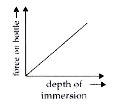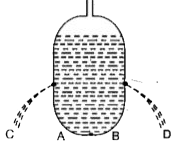Fix a whistle in a hole made at the bottom of a soft drink bottle. Immerse the bottle upside down In water after taking the lid away from it. When the bottle gets filled with water lift the bottle out of the water. The whistle starts producing a sound while water flows down through the mouth. Why is it so?
The atmospheric air that rushes into the empty space created by the downward flow of water produces the whistling sound.
Similar Questions
Knowledge Check
An empty plastic bottle closed with an airtight stopper is pushed down into a bucket filled with water. As the bottle is pushed down, there is an increasing force on the bottom as shown in graph . This is because
 Amore volume of liquid is displacedBmore weight of liquid is displacedCpressure increases with depthDall of the above .
Amore volume of liquid is displacedBmore weight of liquid is displacedCpressure increases with depthDall of the above .
When hot water is placed into an empty water bottle, the bottle keeps its shape and does not soften. What type of plastic is the water bottle made from?
View SolutionWhy is there a fizz when a soda water bottle is opened?
View SolutionAn empty plastic bottle is kept and three holes are made in it at the same height from the bottom of the bottle. Bottle is now filled with water. Water stands leaking out 'from the holes. Do the different stream of water coming out of the holes fall at the same distance from the bottle? What conclusion do you draw ?

View SolutionExplain the following:
Why do soft drink bottles cool better in ice at 0∘C than water at 0∘C?
View SolutionA tightnened glass stopper can be taken out easily by pouring hot water around the nect of the bottle. Why it is so?
View SolutionWhat will happen if you make two tiny holes of the same size at equal heights from the bottom in a plastic bottle filled with water? What does this experiment prove?

View SolutionTwo tiny holes are made in a plastic bucket, one near the middle part and the other just above bottom.When this bucket is filled with water, the water rushes out from the bottom hole much faster than from the upper hole. What conclusion do you get from this observation ?
View Solution
